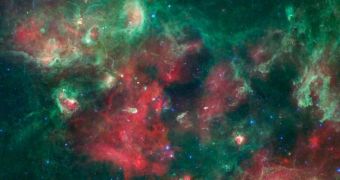Before the Sun had planets and space rocks surrounding it on all sides, it formed inside a stellar cocoon that existed in a very chaotic stellar nursery. A similar scene was recently imaged with the NASA Spitzer Space Telescope, and the image shows an area that may soon spawn a Sun-like star.
The observations were conducted by experts at the Harvard-Smithsonian Center for Astrophysics (CfA), in Cambridge, Massachusetts, who were led by Joseph Hora. He explains that the dust and gas cloud is located about 4,500 light-years away, in the direction of the constellation Cygnus.
The stellar nursery forms new stars at a frantic pace, which is one of the main reasons why Spitzer was trained on it in the first place. Thousands of new cosmic fireballs can be observed in the new image; and most of them are very similar to our Sun.
This type of studies could help astronomers figure out more about how the solar system appeared and evolved over time. These researches could also help us figure out how stars escape from their birth place, thus becoming able to host planets.
Some of the stars that form in nurseries do not remain part of clusters, but rather tend to move farther away from each other, and set up individual star systems. The interesting part about this is that it implies that the Sun was also a part of such a collection of stars.
Astronomers explain that the interior of a stellar nursery is riddled with huge cavities. These are bubbles created in the surrounding gas/dust mixture, which were carved out by intense winds from blue stars. When massive stars explode, the force of the blasts separates the mixture even more.
“One of the questions we want to answer is how such a violent process can lead to both the death and birth of new stars. We still don't know exactly how stars form in such disruptive environments,” says Spitzer Science Center study team member Sean Carey.
The SSC is a division of the California Institute of Technology (Caltech), in Pasadena, and is in charge of processing all Spitzer data. An infrared telescope is being used for such studies because it can pierce through the thick layers of dust surrounding forming stars.
In this particular image, blue is color-coded to 3.6 microns, blue-green to 4.5 microns, green to 8.0 microns and red to 24 microns. The snapshot was taken before Spitzer ran out of coolant and began its warm mission, in 2009.

 14 DAY TRIAL //
14 DAY TRIAL //